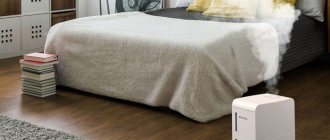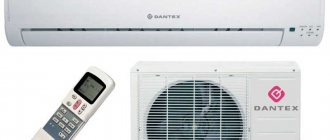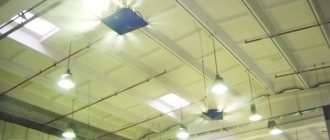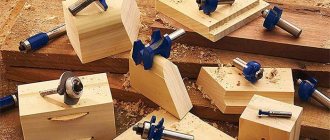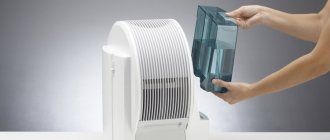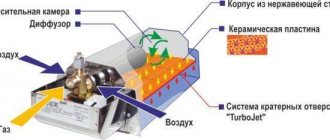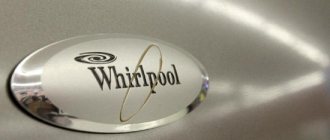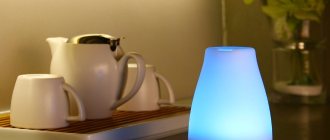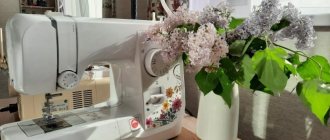Air humidity is one of the most important criteria for good health. Lack of moisture in the atmosphere of an apartment leads to loss of strength, dry mouth, peeling skin, and exacerbation of respiratory diseases. In addition to health, wooden furniture also suffers, cracking and losing strength. The normal winter level is 30-45%, however, constantly turned on heating dries out the air greatly, and ventilation will not help here - the humidity outside the window may be even lower. The solution is to purchase an air humidifier.
Depending on the method of operation, there are the following types of air humidifiers:
- Cold steam;
- Hot steam;
- Ultrasonic;
- Adiabatic air humidifier.
ATTENTION! To determine whether humidifiers are needed, you should measure the humidity level in your home. The measurement is carried out with a hygrometer, which can be purchased at a hardware store or ordered online. If the humidity level is at the level of 50-60%, additional air humidification is not required; any equipment can even cause harm, creating excess moisture in which mold and painful microorganisms quickly appear. Humidification equipment is needed if the humidity is below 45%.
Traditional humidifiers
A traditional humidifier is otherwise called a cold steam device. The device operates on the simplest principle: water in the housing saturates the evaporative elements, which are blown by an air flow created by a fan, thereby causing moisture to evaporate and saturate the air with it.
The evaporators of these devices are made in the form of cartridges. The cheapest devices are equipped with paper evaporative elements, the more expensive ones are equipped with cartridges in the form of plastic disks, which constantly rotate, become saturated with water, and release moisture.
The presence of cartridges allows you to additionally filter the air and clean it of dust. To extend their service life, it is better to use distilled or well-purified water. Such a humidifier for the home is often equipped with additional functions - ionizers, air washing, etc.
The main advantage of the device is that it uses the natural evaporation process. The rate at which the home atmosphere is saturated with moisture depends on the initial humidity level: the drier the air, the more water evaporates. About 3.5-8 liters are consumed per day, the power consumption of the gadget is 20-50 W.
Another advantage is that you don’t need a hygrostat in the humidifier. When the humidity reaches 60%, evaporation simply does not occur or occurs very slowly - there is no fear of over-humidifying the air.
HELP: What is a hygrostat? This is a device that measures humidity and turns off the humidifier when it reaches a predetermined level. It can be analog and digital.
The third advantage is ease of maintenance. Cartridges are quite easy to change; on average, one cartridge needs to be replaced every two to three months.
The disadvantage of this type of device is the noise level, reaching 45 decibels. It can be used in living rooms, kitchens, and other non-residential premises, but in bedrooms, especially at night, it can cause discomfort.
Steam humidifier
The operating principle of these devices is reminiscent of an electric kettle. Inside there is a container of water that is constantly boiling. When boiling, steam is released, which is a source of humidification for the air. All humidifiers of this type are equipped with an automatic shut-off function when the water completely boils away. They must have a hygrostat, since otherwise the humidity level may greatly exceed the recommended values, which will lead to the formation of condensation on windows and other surfaces, and this can negatively affect health and overall comfort.
Main advantages:
- Rapid saturation with moisture;
- High power - 7-16 liters of water per day;
- Additional functions;
- Undemanding to water quality;
- Fire safety.
These types of air humidifiers are simply ideal for medical purposes: they can be used as inhalers thanks to special attachments. You can add oils, herbal infusions, and medicines to the water, which will evaporate and aromatize the room or have a beneficial effect on the respiratory tract.
Steam household humidifiers work great even with the hardest and most contaminated water. However, it is better to use a cleaned one, since otherwise scale will form inside, which will have to be cleaned. You can do this with soda or sponges, but you should be careful when cleaning so as not to leave deep scratches.
These devices have a well-thought-out fire safety system. They turn on only when fully assembled and when there is no danger of touching bare wires, which reduces the risk of fire short circuits to a minimum.
Such moisturizers are not without their disadvantages:
- High electricity consumption;
- High noise level;
- Possibility of getting burned by the steam jet.
The power of steam humidifiers is 300-600 watts or more. If they operate continuously, energy consumption increases significantly. At the same time, boiling creates a high noise level, which limits the scope of application of the device - it is ideal for greenhouses, small greenhouses, non-residential rooms, but is poorly suited for bedrooms.
IMPORTANT: The average temperature of the exiting steam is 50-60 degrees, sometimes higher, which requires careful handling of this unit. When it is working, it is important to supervise children so that they do not accidentally get burned.
Ultrasonic humidifiers
Ultrasonic humidifiers, on the contrary, are the most modern. Due to vibration, the water is split into tiny particles and comes out as a cloud that looks like cold steam. Like the traditional option, the ultrasonic type of humidification is classified as “cold”, which means that in hot weather it will be very useful. Ultrasonic devices can maintain humidity from 20 to 90%. With a built-in hygrometer, the humidifier itself can analyze the air in the room and turn on when it becomes too dry.
With ultrasonic humidification, the water is not treated, so the fumes from untreated water can be harmful to health and leave a white residue on furniture and everyone around. It is better to use distilled water or pay attention to the filtration system in the humidifier. Even with good filters, it is better to purify the water first.
The range of such humidifiers is wide, and the price is varied. The simplest models cost a little more than a thousand rubles. Models with optimal price/quality are in the range of 4-7 thousand rubles.
Ultrasonic freshener-humidifier
This is the most modern and one of the most effective home air humidifiers. The device is quite simple: water flows from a container onto a special membrane, which vibrates at a very high frequency (ultrasound level) and breaks the liquid into tiny droplets. Weightless water dust is lifted by a fan and released outside.
A trickle of steam resembles fog, which is why such devices are sometimes called fog generators or fresheners. This steam is cold and wet, it does not pose any threat, having a maximum temperature of 40 degrees Celsius - it is impossible to get burned by it.
Ultrasonic humidifiers are complemented by high-precision hygrostats, which allow precise regulation of the degree of humidity. Daily water consumption is 6-13 liters with a power consumption of 30-60 W.
It is recommended to use distilled or very pure water for this device. Otherwise, its service life is shortened, and a white coating may settle on the surface of the home furnishings - fine dust consisting of salts and minerals contained in the poured liquid. It's not very good for your household items or your lungs.
The advantages of such models:
- Quiet operation;
- Possibility of remote control;
- Decorative;
- Safety.
Thanks to the use of modern technologies, air humidification with such devices occurs with minimal
noise level - up to 25 decibels. This feature makes this humidifier ideal for use in bedrooms at night, especially in children's bedrooms.
Ultrasonic devices are controlled both by traditional buttons and regulators located on the body, and through remote controls. Products are often equipped with displays that display information about humidity levels, operating time, air temperature and other indicators of the room atmosphere.
One of the main advantages is that most of these devices have an unusual design. They are often equipped with backlighting, which turns them not only into functional humidifiers, but also into night lights. This feature allows you to make the children's room more comfortable.
Sometimes users are put off by the ultrasonic principle of operation. However, ultrasound in this case is completely safe - it is not perceived by the hearing organs of households and pets, no dangerous radiation is used, only mechanical vibrations of the membrane that whips water into vaporous dust.
The main disadvantage of ultrasonic devices is the considerable cost of “sophisticated” devices and the need for careful maintenance. They use special cartridges, the fillers of which require regular replacement. But the cleaner the water, the less often they have to be changed.
What types of air humidifiers are there for the home?
Home air humidifiers are divided into several types according to their design and operating principle. There are significant differences between them in terms of power and functionality.
Traditional humidifiers
Traditional humidifiers operate on the principle of cold evaporation. There is no heating of water in them. Liquid molecules simply evaporate from a special tray, after which the cooler disperses them along with the air throughout the room.
A traditional humidifier can evaporate an average of 3-9 liters of water per day. The advantages of such devices include, first of all, the fact that the operation of the device does not need to be monitored. Water will evaporate more actively at low humidity levels in the room, and at normal levels the process will slow down naturally.
Another advantage of the traditional unit is the absence of steam. The humidifier does not cause burns; during its operation, a whitish coating does not appear on the surfaces of furniture and equipment.
The main disadvantage of the traditional device is its low performance in large rooms and special requirements for water quality. You need to fill the unit with filtered or distilled liquid, otherwise the filters will quickly become clogged with hard particles.
Traditional humidifiers are equipped with paper or plastic filters and additionally purify the air.
Steam humidifiers
Room humidifiers are steam-powered and operate on the principle of an electric kettle. The water in them is heated to boiling point, and then enters the surrounding space in the form of hot steam.
The devices have high performance and are suitable for normalizing the microclimate in spacious rooms. The beneficial effect of the steam unit appears very quickly. Most models of devices are equipped with a hygrostat, which measures the level of air humidity and gives the device a command to turn off after reaching the required levels.
A steam humidifier uses an average of 6-17 liters of water per day and consumes up to 1000 W of electricity
Steam humidifiers are inexpensive and perform well. But their disadvantage is the low level of security. Hot steam can cause burns if the device is handled carelessly. Injuries can occur if the unit tips over.
Advice! It is not recommended to place a steam humidifier on a work desk or in close proximity to a sleeping area.
Ultrasonic humidifiers
Ultrasonic humidifiers are very popular. They work on the following principle: liquid from the reservoir is supplied to a special membrane that vibrates in the high-frequency range. Water breaks down into tiny particles and turns into cold fog, or wet dust, which the built-in cooler spreads throughout the room.
Ultrasonic device models have numerous advantages:
- They make virtually no noise during operation and are suitable for use at night;
- do not pose a danger to humans because they do not heat water above 40 °C;
- quickly and effectively raise the humidity level in the room to the desired values.
Ultrasound devices often support control via a remote control or an application on a smartphone.
Ultrasonic humidifiers consume only about 60 W of energy, but can evaporate more than 10 liters of water per day
Despite numerous advantages, the devices have their disadvantages. First of all, the disadvantages include high cost. In addition, only distilled water must be filled into the reservoir of the high-frequency device.
When using ultrasonic humidifiers, a white coating often appears on furniture and other surfaces. It is a salt deposit from water. Since the liquid is not boiled, hard particles in its composition do not settle to the bottom and walls of the device, but are carried throughout the room along with cold fog.
Air washing humidifiers
The design of the sinks is most similar to traditional humidifiers, but they are equipped with a larger and more powerful paddle cooler. During operation of the device, the fan captures air from the room along with dust particles. Under the influence of centrifugal force, the latter settle on moisturizing disks, partially immersed in water. The cooler then supplies purified air to the room.
Washing has a good effect if there is a lot of dust, animal hair and fluff in the room. The device requires virtually no maintenance, although the water in the pan must be changed from time to time. At the same time, the unit cannot cope with small particles of dirt and allergens - to combat them you need to buy special air purifiers.
Washing systems are capable of removing particles as small as 10 microns from the air.
Combined climate systems
Combined climate systems combine the capabilities of humidifiers and purifiers. A distinctive feature of such units is the presence of a large number of filters. In particular, this type of air humidifier is equipped with:
- carbon filters that retain unpleasant odors;
- photocatalytic elements that purify the air from bacteria, viruses and gases;
- electrostatic filters that effectively attract the smallest dust particles.
The use of climate control systems is useful for allergy sufferers and parents of small children. The devices allow not only to humidify the air, but also to make it almost sterile due to high-quality purification.
Some climate control systems provide ultraviolet lamps for air disinfection
Atomizer or adiabatic humidifier
The listed types and types of air humidifiers are home-made, suitable for use in a house or apartment. They are effective in rooms with an average area of up to 60 square meters. However, what if you need not a household appliance, but a device that can cope with a large area of an industrial greenhouse, workshop or huge warehouse?
In such situations, an adiabatic humidifier or a spray-type device is most suitable. Its operating principle boils down to spraying water, which is supplied to special nozzles under high pressure. Passing through the nozzle, the liquid breaks up into microscopic droplets - their size is 3-8 micrometers. The water suspension flies away from the device at a distance of 20-50 centimeters and is completely converted into steam, distributed throughout the entire area of the room.
An adiabatic air humidifier has small dimensions but enormous power. It is often attached to the wall and passes through 50 to 250 liters of water every hour. There is no need to use such a device at home, but it is ideal for workshops and warehouses.
The main advantage is the possibility of constant use at any time of the year. An adiabatic humidifier consumes a moderate amount of energy and can be configured in a variety of ways to create specific storage conditions for rare or sensitive items in your warehouse. Individual assembly of devices is allowed - this is the second advantage that no other type of humidifier has.
An adiabatic air humidifier has one, but very significant drawback - huge cost. It reaches several thousand dollars. Cost fluctuations depend on additional functions and the scope of delivery to the enterprise from the manufacturer.
What to look for when choosing
When choosing suitable humidifiers, you should consider:
- The place where they will be used;
- Room area;
- Noisiness;
- Dimensions and installation method;
- Difficulty of maintenance;
- Availability of additional functions.
The way a device operates directly affects where it will be used. Thus, an adiabatic air humidifier is suitable only on an industrial scale, a traditional one (cold steam) - in kitchens, living rooms, less often in bedrooms, a steam humidifier (hot steam) - in greenhouses and non-residential rooms, an ultrasonic one - in any room of a house or apartment.
The selected unit must be able to create the desired level of humidity in the room. It depends on the power of the device. The higher it is, the greater the air volume served.
ATTENTION: To use the product comfortably, you need to choose the option with the lowest noise level. Already at 35-45 decibels the noise becomes very clearly audible and sometimes interferes with rest or sleep.
The devices differ not only in power, noise and type of operation, but also in dimensions and installation methods.
Miniature devices designed for small rooms often plug directly into an outlet, without cords. Larger products may look vertical or horizontal; accordingly, they occupy different areas - you should provide a place for installation in advance.
If it is not possible to constantly maintain the humidifier or spend additional money on consumables (cartridges, fillers, filters), then it is better to choose the simplest possible device. Otherwise, you can purchase a unit that not only humidifies the air, but also cleans it of dust and saturates it with charged ions, which also helps to settle dust particles and get rid of flying pathogenic bacteria. These combined devices are called air washers or climate control systems.
IMPORTANT: Standard humidifiers should not contain fragrance oils or other fragrances. When mixed with water, they can turn into sediment, scale or suspension, which negatively affects the operation of the device and quickly disables it. If you want to further saturate your home atmosphere with a pleasant smell, it is better to choose a device that is equipped with separate containers for oils and aromas.
Advantages and disadvantages of different types of humidifiers
Which type of air humidifier is better for an apartment cannot be answered unequivocally. They all have their own advantages and weaknesses and are designed to solve different problems:
- Traditional air humidifiers are well suited for improving the microclimate in a small and fairly clean room. Their operating principle is very simple, and they are inexpensive. But if there is a lot of dust in the apartment, and the space itself is large, such a unit will be of little use.
- Ultrasonic models are the most convenient to use and have the widest functionality. But you need to use the highest quality water with them, otherwise a noticeable white coating will remain on the furniture.
- Steam appliances cope well with large rooms and humidify the air quickly and efficiently. However, they cannot be used in apartments with pets and small children, since the units are quite dangerous.
- Air washers are ideal for cleaning a room from dust and hair, serve large spaces and require minimal control from the user. The disadvantages include the dimensions of such units and the need for frequent water changes. In addition, the sink does not cope well with humidification - first of all, it is intended specifically for cleaning the air from dust.
- Climate complexes are considered the most functional of all varieties. They cope equally well with both humidification and air purification. But the cost of such devices is very high.
After comparing the types of air humidifiers, if you have modest requirements for equipment, it is better to choose an inexpensive and compact device of an ultrasonic or traditional type. If the apartment is large, and dust and wool cause serious trouble, it makes sense to purchase a sink or an air conditioner.
